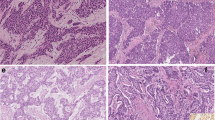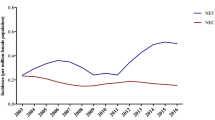Abstract
Purpose
The recent WHO classification of breast cancer (2019) categorizes breast carcinoma with neuroendocrine (NE) differentiation into three morphologically distinct subtypes: well-differentiated neuroendocrine tumor (NET), poorly differentiated neuroendocrine carcinoma (NEC), and invasive breast carcinoma, no special type with neuroendocrine differentiation (IBC-NST-NE). Data regarding the prognostic significance of neuroendocrine differentiation are conflicting and an association, if any, between p53 mutation and neuroendocrine differentiation is largely unknown.
Methods
We examined p53 expression and other clinicopathologic characteristics in three types of invasive breast carcinoma with NE differentiation in a cohort of sixty-three patients, including 45 IBC-NST with NE differentiation, 10 NETs, and 8 NECs.
Results
No significant difference of clinicopathologic feature was observed between IBC-NST with NE differentiation and NET, but NECs showed significantly lower expressions of hormone receptors, more mutated p53, and higher frequency of distant metastases than IBC-NST with NE differentiation and NETs.
Conclusion
NECs of the breast are genetically and clinically different from IBC-NST-NEs and NETs of the breast.


Similar content being viewed by others
References
Tavassoli F, Schnitt S, Hoefler H (2003) Intraductal proliferative lesions. In: Tavassoli F, Devilee P (eds) World Health Organization classification of tumours. Pathology and genetics of tumours of the breast and female genital organs. IARC press, Lyon
Feyrter F (1963) On the carcinoid growth form of the carcinoma mammae, especially the carcinoma solidum (gelatinosum) mammae (in German). Frankf Z Pathol 73:24–39
Miremadi A, Pinder S, Lee A et al (2002) Neuroendocrine differentiation and prognosis in breast adenocarcinoma. Histopathology 40(3):215–222
Gallo M, Campione S, Di Vito V et al (2021) Primary neuroendocrine neoplasms of the breast: still open issues. Front Endocrinol. https://doi.org/10.3389/fendo.2020.610230
Tan PH, Ellis I, Allison K et al (2020) The 2019 World Health Organization classification of tumours of the breast. Histopathology. https://doi.org/10.1111/his.14091
Rindi G, Klimstra DS, Abedi-Ardekani B et al (2018) A common classification framework for neuroendocrine neoplasms: an International Agency for Research on Cancer (IARC) and World Health Organization (WHO) expert consensus proposal. Mod Pathol 31(12):1770–1786
Pareja F, D’Alfonso TM (2020) Neuroendocrine neoplasms of the breast: a review focused on the updated World Health Organization (WHO) morphologic classification. Breast J 26(6):1160–1167
Yang L, Roy M, Lin H et al (2021) Validation of prognostic significance of the proposed uniform classification framework in neuroendocrine neoplasms of the breast. Breast Cancer Res Treat 186(2):403–415
Biganzoli E, Coradini D, Ambrogi F et al (2011) p53 status identifies two subgroups of triple-negative breast cancers with distinct biological features. Jpn J Clin Oncol 41(2):172–179
Bean GR, Najjar S, Shin SJ et al (2022) Genetic and immunohistochemical profiling of small cell and large cell neuroendocrine carcinomas of the breast. Mod Pathol 35(10):1349–1361
Wang J, Wei B, Albarracin CT, Hu J, Abraham SC, Wu Y (2014) Invasive neuroendocrine carcinoma of the breast: a population-based study from the surveillance, epidemiology and end results (SEER) database. BMC Cancer 14:147
Rovera F, Masciocchi P, Coglitore A et al (2008) Neuroendocrine carcinomas of the breast. Int J Surg 6:S113–S115
Lavigne M, Menet E, Tille J-C et al (2018) Comprehensive clinical and molecular analyses of neuroendocrine carcinomas of the breast. Mod Pathol 31(1):68–82
Tian Z, Wei B, Tang F et al (2011) Prognostic significance of tumor grading and staging in mammary carcinomas with neuroendocrine differentiation. Hum Pathol 42(8):1169–1177
Zekioglu O, Ylz Erhan, Çiriş M, Bayramoglu H (2003) Neuroendocrine differentiated carcinomas of the breast: a distinct entity. Breast. 12(4):251–257
Lopez-Bonet E, Alonso-Ruano M, Barraza G, Vazquez-Martin A, Bernado L, Menendez JA (2008) Solid neuroendocrine breast carcinomas: incidence, clinico-pathological features and immunohistochemical profiling. Oncol Rep 20(6):1369–1374
Lavigne M, Menet E, Tille J-C et al (2018) Comprehensive clinical and molecular analyses of neuroendocrine carcinomas of the breast. Mod Pathol 31(1):68–82
Koboldt D, Fulton R, McLellan M et al (2012) Comprehensive molecular portraits of human breast tumours. Nature 490(7418):61–70
Li J-p, Zhang X-m, Zhang Z, Zheng L-h, Jindal S, Liu Y-j (2019) Association of p53 expression with poor prognosis in patients with triple-negative breast invasive ductal carcinoma. Medicine. https://doi.org/10.1097/MD.0000000000015449
Gasco M, Shami S, Crook T (2002) The p53 pathway in breast cancer. Breast Cancer Res 4(2):1–7
Ang D, Ballard M, Beadling C et al (2015) Novel mutations in neuroendocrine carcinoma of the breast: possible therapeutic targets. Appl Immunohistochem Mol Morphol 23(2):97–103
Marchiò C, Geyer FC, Ng CK et al (2017) The genetic landscape of breast carcinomas with neuroendocrine differentiation. J Pathol 241(3):405–419
Wei B, Ding T, Xing Y et al (2010) Invasive neuroendocrine carcinoma of the breast: a distinctive subtype of aggressive mammary carcinoma. Cancer 116(19):4463–4473
Wei Y, Ke X, Yu J et al (2022) Clinical and genomic analyses of neuroendocrine neoplasms of the breast. Mod Pathol 35(4):495–505
Lakhani SR, Ellis IO, Schnitt S, Tan PH, van de Vijver M (2012) WHO classification of tumours of the breast. International Agency for Research on Cancer, Lyon
Tang F, Wei B, Tian Z et al (2011) Invasive mammary carcinoma with neuroendocrine differentiation: histological features and diagnostic challenges. Histopathology 59(1):106–115
Makuuchi R, Terashima M, Kusuhara M et al (2017) Comprehensive analysis of gene mutation and expression profiles in neuroendocrine carcinomas of the stomach. Biomed Res 38(1):19–27
Pizzi S, Azzoni C, Bassi D, Bottarelli L, Milione M, Bordi C (2003) Genetic alterations in poorly differentiated endocrine carcinomas of the gastrointestinal tract. Cancer Interdiscip Intern J Am Cancer Soc 98(6):1273–1282
Furlan D, Cerutti R, Uccella S et al (2004) Different molecular profiles characterize well-differentiated endocrine tumors and poorly differentiated endocrine carcinomas of the gastroenteropancreatic tract. Clin Cancer Res 10(3):947–957
Sahnane N, Furlan D, Monti M et al (2015) Microsatellite unstable gastrointestinal neuroendocrine carcinomas: a new clinicopathologic entity. Endocr Relat Cancer 22(1):35–45
Chan AO-O, Kim SG, Bedeir A, Issa J-P, Hamilton SR, Rashid A (2003) CpG island methylation in carcinoid and pancreatic endocrine tumors. Oncogene 22(6):924–934
Funding
None.
Author information
Authors and Affiliations
Contributions
Study design: All. Data collection: SS, YH, AVP, QD, and ZL. Data analysis: SS, YH, QD, and ZL. Statistical oversight: SS. Manuscript preparation: SS, YH, AVP, QD, and ZL. Manuscript approval: All.
Corresponding author
Ethics declarations
Conflict of interest
The authors declare that they have no financial relationship to disclose.
Ethical approval
All procedures performed in studies involving human participants were in accordance with the ethical standards of the institutional and/or national research committee and with the 1964 Helsinki declaration and its later amendments or comparable ethical standards. This article does not contain any studies with animals performed by any of the authors.
Informed consent
Informed consent was obtained from all individual patients included in the study.
Additional information
Publisher's Note
Springer Nature remains neutral with regard to jurisdictional claims in published maps and institutional affiliations.
Rights and permissions
Springer Nature or its licensor (e.g. a society or other partner) holds exclusive rights to this article under a publishing agreement with the author(s) or other rightsholder(s); author self-archiving of the accepted manuscript version of this article is solely governed by the terms of such publishing agreement and applicable law.
About this article
Cite this article
Shafi, S., Hu, Y., Parwani, A.V. et al. Comprehensive analysis of clinicopathologic features and p53 mutation in neuroendocrine neoplasms of the breast: experience from a large academic center. Breast Cancer Res Treat 196, 463–469 (2022). https://doi.org/10.1007/s10549-022-06766-2
Received:
Accepted:
Published:
Issue Date:
DOI: https://doi.org/10.1007/s10549-022-06766-2




